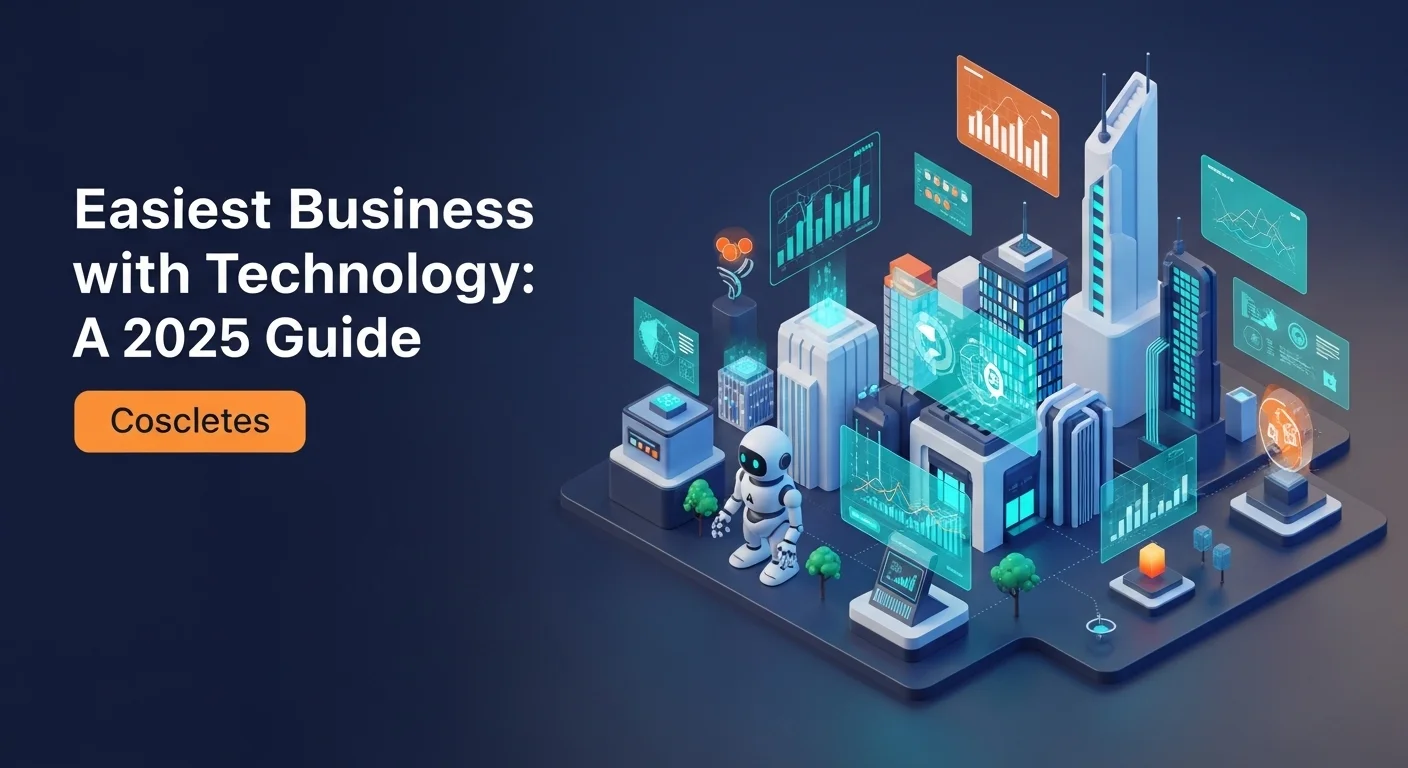AI in Business: Your Practical Guide to Building a Smarter Company

Executive Summary
In my years as a consultant, I've seen artificial intelligence evolve from a futuristic buzzword into a fundamental tool for business success. This article is your guide to that transformation. We'll cut through the hype and explore how AI is genuinely reshaping industries today. It’s about more than just automation; it's about making smarter decisions, understanding your customers on a deeper level, and finding new ways to grow. We'll cover the essential concepts, like how AI differs from the business intelligence tools you're already using, and look at practical examples from companies just like yours. Whether you're an entrepreneur, a manager, or just curious about tech, this guide will give you a clear understanding of how integrating AI can create a more efficient, innovative, and competitive business in today's digital world.
Table of Contents
Table of Contents
- What Does AI in Business Really Mean?
- The Power Couple: When Business Intelligence Meets AI
- Real-World Impact: AI in Action Today
What Does AI in Business Really Mean?
Let's simplify things. When we talk about putting AI into a business, we're talking about a major upgrade. It’s like moving from a simple calculator to a super-smart assistant that not only crunches numbers but also spots trends, makes predictions, and even suggests your next move. It’s a partnership between human expertise and machine intelligence. For years, I've watched companies transition from basic automation to this deeper, more symbiotic relationship with technology. It’s no longer about if a business should adopt AI, but how. Those who embrace it are quicker to react to market shifts, anticipate what their customers want before they do, and run their operations with incredible efficiency. This integration isn't just a tech trend; it's the new standard for staying competitive.
To really get it, you have to know the key players in the AI toolkit. Think of Artificial Intelligence (AI) as the overall brain. Under that umbrella, you have a few key specialists: Machine Learning (ML) is the part of the brain that learns from experience. You feed it data, and it learns to make predictions without you having to write a million rules. Deep Learning is an even more advanced form of ML, using complex networks to recognize intricate patterns, which is why it's great for things like understanding images or speech. Then there's Natural Language Processing (NLP), the specialist that understands and speaks human language. It’s the magic behind chatbots and tools that can read a customer review and understand if it's happy or angry. These are the building blocks that allow a business to become truly intelligent.
The Power Couple: When Business Intelligence Meets AI
Many businesses are comfortable with Business Intelligence (BI). For years, BI tools have been giving us charts and dashboards that tell us what happened last quarter or last year. It’s descriptive; it looks in the rearview mirror. But when you infuse that BI with AI, everything changes. I call this the move from reactive to proactive. Instead of just telling you what happened, an AI-powered BI system can tell you what's likely to happen next (predictive analytics) and even suggest what you should do about it (prescriptive analytics). I’ve seen this transform companies. An e-commerce store, for instance, no longer just sees that sweaters sold well in winter. Now, it can predict which styles will be popular next season, identify customers who are about to stop buying, and automatically offer them a personalized discount to stay. It's a strategic game-changer.
Real-World Impact: AI in Action Today
The best way to understand AI's power is to see it at work. These aren't sci-fi fantasies; they're happening right now. In customer service, AI chatbots handle thousands of queries instantly, freeing up human agents for more complex problems. I've helped companies implement these and watched customer satisfaction scores climb. We've all experienced the personalization engines of Netflix and Amazon; that’s AI analyzing our behavior to say, 'Hey, you might like this.' It feels personal because it is. In finance, AI is the silent guardian, scanning millions of transactions a second to spot fraud before it happens. And in healthcare, I’ve been amazed by AI systems that can help doctors detect diseases in medical scans with astonishing accuracy. These examples are just the beginning, showing how AI is making business more personal, secure, and efficient across every single industry.
It doesn't stop there. Take a look at manufacturing. I've toured smart factories where AI predicts when a machine will break down, scheduling maintenance before it can disrupt production. This is called predictive maintenance, and it saves companies millions. In logistics, AI is the master coordinator, optimizing delivery routes by analyzing traffic, weather, and fuel consumption in real-time. It’s why your packages arrive on time more often than not. Even creative fields are being touched. There are AI tools that can help designers generate new ideas or musicians compose new melodies. The key takeaway I always share with clients is this: AI isn't a single solution; it's a versatile tool that offers a unique competitive advantage to any business willing to explore its potential. This isn't just a tech update; it's a fundamental business evolution.

How to Actually Implement AI in Your Business: A Step-by-Step Guide
Bringing AI into your business can feel like a massive undertaking, but I've found it's most successful when you follow a clear, strategic roadmap. The first and most important step is to forget about the technology for a moment and focus on your business goals. Ask yourself: what are our biggest challenges or opportunities? Where are we wasting time? What do our customers complain about most? Start there. A solid AI strategy always connects directly to solving a real problem. For example, instead of saying 'we need an AI,' say 'we need to reduce customer support response times by 50%.' This clarity is essential. Then, you need to look at your data. AI is powered by data, so you must have good, clean, and relevant data to work with. I always tell my clients that this initial data-readiness assessment is the single most critical factor for success. It’s the foundation upon which everything else is built.
The Right Methods for the Job
Once you have a clear goal, you can choose the right tools. If your goal is better customer support, you'll look into Natural Language Processing (NLP) and chatbot platforms. If you want to forecast sales, you'll explore Machine Learning (ML) models for predictive analytics. My advice is always to start small. Don't try to overhaul your entire company at once. Launch a pilot project—a small-scale experiment to prove the concept. This lets you learn, make mistakes cheaply, and show some early wins to get everyone on board. From a project management perspective, an agile approach works best. AI projects are rarely linear; you'll constantly be testing, learning, and refining your models. An agile mindset allows you to be flexible and ensures the final product truly meets the needs of the business.
Diving Deeper: More Practical AI Examples
Let's make this more concrete. I worked with a retail client struggling with customer churn. We used their existing data—purchase history, website clicks, support tickets—to build an ML model that could predict which customers were at high risk of leaving. The system would then automatically flag these customers for the marketing team, who could reach out with a special offer or a personal check-in. It was a proactive strategy that directly boosted their retention rates. In another case, a marketing agency used a generative AI tool to create dozens of ad variations—different headlines, images, and calls to action. An AI testing platform then ran small experiments to see which combinations worked best for different audiences. This not only saved their creative team countless hours but also dramatically improved their campaign ROI. These examples show how specific AI tools can be applied to solve specific, measurable business problems.
The Tools and Platforms at Your Fingertips
The great news is, you don't need a team of PhDs from MIT to get started anymore. The rise of cloud computing has made powerful AI tools accessible to everyone. Giants like Amazon Web Services (AWS), Google Cloud, and Microsoft Azure offer entire suites of AI services. You can use pre-trained models for tasks like image recognition or sentiment analysis, or you can use their platforms—like SageMaker, Vertex AI, or Azure Machine Learning—to build your own custom solutions. These platforms have been a game-changer, especially for small and medium-sized businesses, allowing them to compete without a massive upfront investment. On top of that, there's a huge open-source community with amazing libraries like TensorFlow and PyTorch. The barrier to entry has never been lower, making it easier than ever for any business to start experimenting with AI.
A Key Decision: Build vs. Buy
Sooner or later, you'll face a critical decision: should we build our own custom AI solution or buy a ready-made one from a vendor? There’s no single right answer. Building it yourself gives you complete control and a solution perfectly tailored to your needs. This can be a powerful competitive advantage. However, I've seen companies underestimate the cost and effort involved; it requires a skilled team and ongoing maintenance. Buying a solution is typically faster and cheaper upfront and requires less technical expertise. The downside is that it might not fit your processes perfectly, and you're dependent on the vendor. Often, the best path is a hybrid one. You might buy an off-the-shelf AI-powered CRM but build a custom model for your core business process that gives you a unique edge. Thinking through this build-vs-buy question is a crucial part of your strategic journey into AI.

Expert Tips for Long-Term AI Success
From my experience, a successful AI integration goes far beyond the technology itself. It’s about building a supportive culture and a smart strategy. To truly get the most out of AI, here are the tips I share most often with business leaders. First, you have to create an AI-ready culture. This means getting everyone, from the C-suite to the front lines, comfortable with data. Invest in training to promote 'data literacy.' When your team understands the basics of how AI works, they'll be more likely to trust its insights and, even better, start spotting new opportunities to use it. This cultural shift has to be led from the top, with leaders who clearly communicate the vision for how AI will help the company and its people thrive.
Putting Ethics and Responsibility First
As AI becomes more integral to your business, you must think about ethics. This is non-negotiable. I strongly advise every company to create a clear AI governance framework. This means setting rules for fairness, accountability, and transparency. For example, if you're using AI to screen job applicants, you must regularly check the system for biases to ensure it’s not unfairly filtering out certain groups. Transparency is also crucial. You should be able to explain, in simple terms, how your AI models make their decisions. This is known as Explainable AI (XAI), and it's essential for building trust with your customers and your team. A responsible approach to AI isn't just good ethics; it's good business that protects you from legal and reputational risk.
Essential Tools to Get You Started
The market for AI tools is vast, but you can focus on a few key areas to begin. Here are the types of tools I consistently recommend:
1. AI-Enhanced Analytics and BI Platforms:
Tools like Tableau and Power BI have become incredibly smart. They let you ask questions in plain English, automatically surface hidden insights in your data, and provide predictive forecasts. They're a fantastic starting point for making smarter decisions across the business.2. AI-Powered CRM Platforms:
I've seen systems like Salesforce Einstein and HubSpot's AI tools completely change how sales and marketing teams work. They can automatically score leads, predict which deals are likely to close, and personalize marketing messages at scale. They handle the busywork so your teams can focus on relationships.3. AI Development Platforms:
For businesses ready to build custom solutions, platforms from AWS, Google, and Azure provide everything you need in one place. They streamline the entire process of building, training, and deploying your own machine learning models. Exploring these tools will give you a tangible sense of what's possible.For a deeper dive into building a robust strategy, I often point clients to external resources. A great one is Gartner's guide on creating an AI Strategy for Business Growth. It provides a solid framework that aligns perfectly with the principles of linking vision to impact and managing risks effectively. Staying informed with high-quality information like this is vital in such a fast-moving field.
Future-Proofing Your Business in the Age of AI
My final piece of advice is to never stop learning. The world of AI is moving at lightning speed. Today's cutting-edge technology will be tomorrow's standard feature. To stay ahead, you must foster a culture of continuous innovation. Encourage experimentation, set aside a budget for R&D, and connect with universities or AI startups. I tell my clients to treat AI not as a project with an end date, but as an ongoing journey of improvement. By staying curious, agile, and proactive, you can ensure your business isn't just surviving the AI revolution but is leading the charge. This forward-looking mindset is the ultimate key to unlocking the transformative potential of AI.
Expert Reviews & Testimonials
Sarah Johnson, Business Owner ⭐⭐⭐
The information is solid, but as a small business owner, I was hoping for more examples I could apply on a smaller budget. It felt a bit geared towards large corporations.
Mike Chen, IT Consultant ⭐⭐⭐⭐
A really solid overview for IT pros. It connected the dots between the tech and the business strategy nicely. I'd have loved a deeper dive into the technical implementation of one of the examples.
Emma Davis, Tech Expert ⭐⭐⭐⭐⭐
Fantastic article! As a tech specialist, I appreciated the comprehensive breakdown. It's well-researched and clearly explains how different AI components come together in a business context. Perfect for my work.



